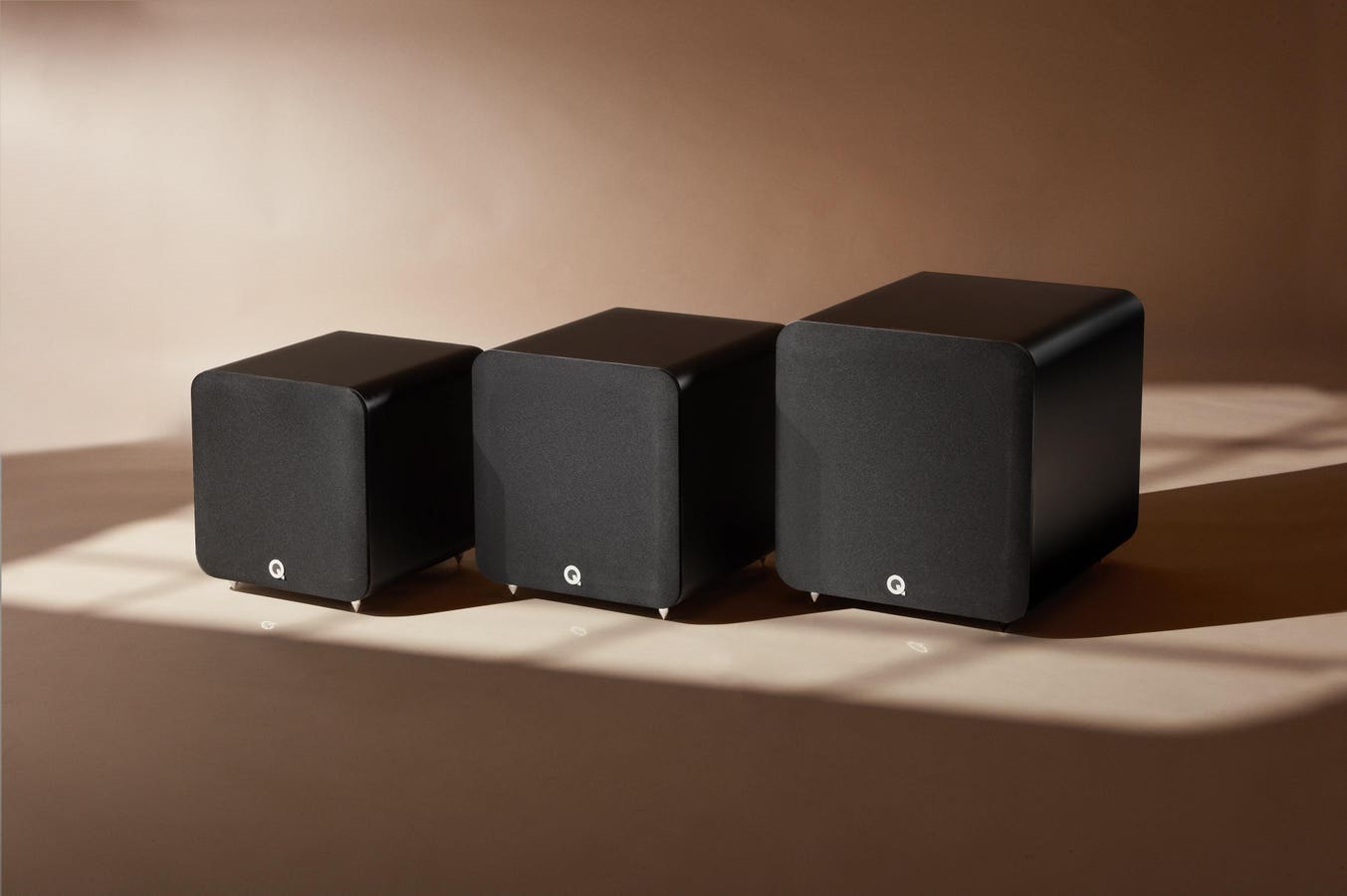Take your pick from a range of sub-woofer sizes. Bigger isn’t always better. Sometimes, two small subs could be an improvement on one large sub.
Q ACOUSTICS
Have you ever thought about getting a subwoofer for your hi-fi? Do you even know what a subwoofer is for? I managed to live through many decades without a subwoofer until I decided to try one for size and now, I don’t think I would want to listen to music without the heft and character that a subwoofer can provide.
To find out more about these big beasts of the audio world, I sat down with Alex Munro, brand director, Q Acoustics, a British speaker brand with a large selection of subwoofers, for a masterclass in all things sub.
Subwoofers are usually used in home theater setups and if you have a 5.1, 5.2 or 7.2 surround sound system for your TV room, you will have at least one subwoofer. These devices can look like a large black box or a trash can, but they provide the low-level grunt and bass frequencies that can bring movies and music to life.
More Immersive Experience
A subwoofer can also provide more bass when you’re using a TV soundbar or a pair of active speakers in what’s known as a 2.1 set-up. A good-quality subwoofer can reach deeper bass levels than even a large pair of floor-standing speakers and will deliver a fuller and more immersive low-end experience.
To produce a deep bass, a subwoofer must physically push around a lot of air to create those low soundwaves. This means a subwoofer needs to incorporate a powerful amplifier for the muscle to push all that air. The bass generally comes from a large woofer that can measure anything from 8 inches up to 21 inches. A large driver is necessary to push the volumes of air that create all those bass frequencies.
A sub-woofer is a good way of boosting the lower frequencies even if you already have floor-standing speakers.
Q ACOUSTICS
It’s always tempting to “go large” when specifying something like a subwoofer, but this, according to Alex Munro, can be too much of a good thing, especially if your listening room is small. In a smaller space, a big subwoofer, played at normal levels, can completely overwhelm and produce too much bass, which swamps the midrange and treble frequencies from the speakers or soundbar.
Alex Munro says it’s important to assess the size of a subwoofer to ensure it matches the size of speakers you are using. For example, bookshelf speakers can’t reproduce much bass because of their small cabinet volume. They simply can’t shift the quantities of air needed to get those big fat bass tones. So, with a pair of bookshelf speakers, you need a subwoofer that can take over the bass duties
However, if you have a large pair of floorstanding speakers, they can already produce a good bass response, so in a 2.1 you’ll need to dial back the crossover point where the subwoofer kicks in and restricts it to reproducing just the very low frequency levels, so a larger subwoofer is beneficial
Location, Location, Location
Where you place the subwoofer matters a lot. Unlike treble and mid frequencies, bass isn’t very directional, so that’s why a subwoofer only needs to be mono. The lack of directionality provides more flexibility in the positioning of the subwoofer. However, every room has certain areas where the bass sounds louder and more defined. These spots can either enhance or distort the sound you get from a subwoofer.
Sub-woofers are not directional so positioning isn’t as critical as placing speakers.
Q ACOUSTICS
To find the best location, Alex Munro suggests you start by locating the subwoofer in line with the main speakers and at a similar distance from the listener, but as central between them as possible. Experimentation is important and a rear, off-center location can work well too.
Set Up Your Subwoofer
Once you’ve found the ideal location for your subwoofer, it will need some fine tuning to get it sounding right. Most subwoofers such as the Q Acoustic models that Alex Munro works with have setup controls: Volume level, delay, phase polarity and crossover frequency. These settings need to be adjusted to your room as well as the main speakers or soundbar you are using.
The subwoofer’s volume should be set conservatively. While a heavy bass is thrilling, less is often more because a thumping bass can make the ears tired. Ideally, you should aim for a level that produces a natural blend with the speakers instead of a dominating thump.
The phase control—often a simple polarity switch—helps ensure the bass from the subwoofer complements the output from the main speakers. Try alternative settings until the sound feels like it’s working with the speakers instead of against them. While you are at it, make sure the main speakers are set up properly with the positive and negative from the amplifier connected to the positive and negative binding posts on both the speakers.
Setting up the controls on the back of subwoofer will make a big difference to the overall sound.
Q ACOUSTICS
The crossover control determines the frequency point where the sub takes over from the speakers. If you set it at too high a level, the bass will overlap awkwardly with the stereo speakers. If it’s set too low, there will be a gap in the sound. For 2.1 Alex Munro suggests checking the specifications of your main speaker system and starting the crossover just below that lower limit. For Home Cinema, set the crossover as high as it can go.
If you’ve set up your subwoofer properly, you shouldn’t notice the bass frequencies as a separate source. Ideally, the bass should augment the main speakers by filling the sound out and underpinning everything with a more dynamic low-end.
Two Are Better Than One
A recent development, according to Alex Munro, is the use of two subwoofers. Despite what I said about a subwoofer not being directional, some people advocate for two subwoofers for their home cinema setup to significantly improve the bass response and overall sound quality.
The reason for this is that multiple subwoofers can help to smooth the bass response over the whole listening area and reduce room modes. A second subwoofer can also provide more headroom by using two smaller subwoofers instead of one large unit.
A subwoofer puts out a lot of energy and having spikes on the base will stop the sub from creeping across the floor.
Q ACOUSTICS
A single subwoofer can create “hot spots” and “dead spots” in a larger room where the bass is either too loud or too weak. Multiple subwoofers placed strategically can help distribute the bass more evenly throughout the room for a more consistent listening experience.
With a single subwoofer, the frequency response can be uneven because of peaks and dips in certain frequency ranges. Multiple subwoofers, when properly placed and calibrated, can help reduce these irregularities, delivering a more balanced and natural-sounding bass. Two smaller subwoofers placed correctly can also be less intrusive than one massive subwoofer.
Reduced Room Modes
Room modes are resonances that occur at specific frequencies caused by the interaction of soundwaves with a room’s dimensions. These modes can cause booming, a muddy bass or areas where there is little to no bass. Dual subwoofers can help fill these areas by distributing the bass energy more evenly for a cleaner and more accurate low-frequency response.
Two subwoofers can also enable each unit to operate at a lower volume with less strain, increasing the system’s headroom. This means the subwoofers can reproduce a louder and more dynamic bass without distorting or clipping, serving up a more powerful and immersive listening experience with more impact.
So, if you’ve been toying with the idea of extending your bass, these tips from Alex Munro and the team at Q Acoustics could help you get the kind of sound you want from your home theater or stereo. You can check out the Q Acoustics subwoofer range here.









